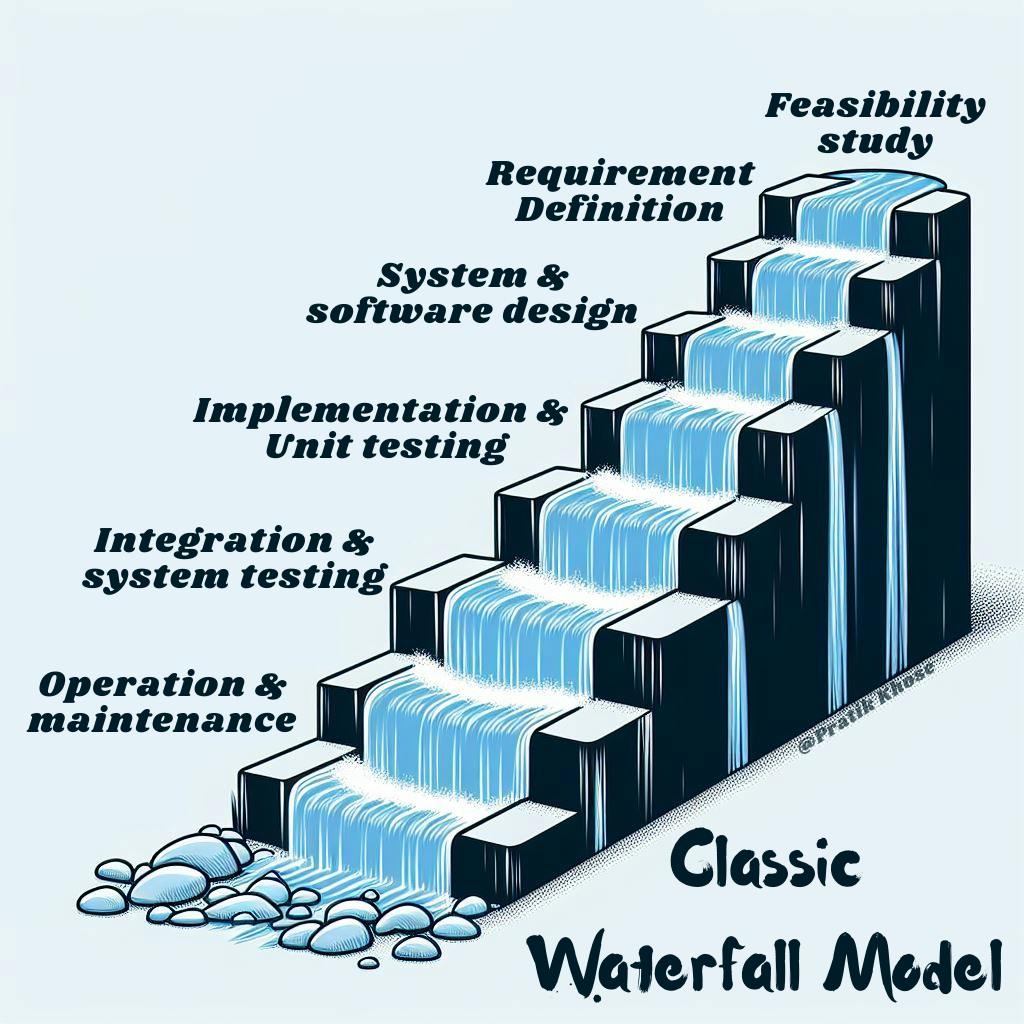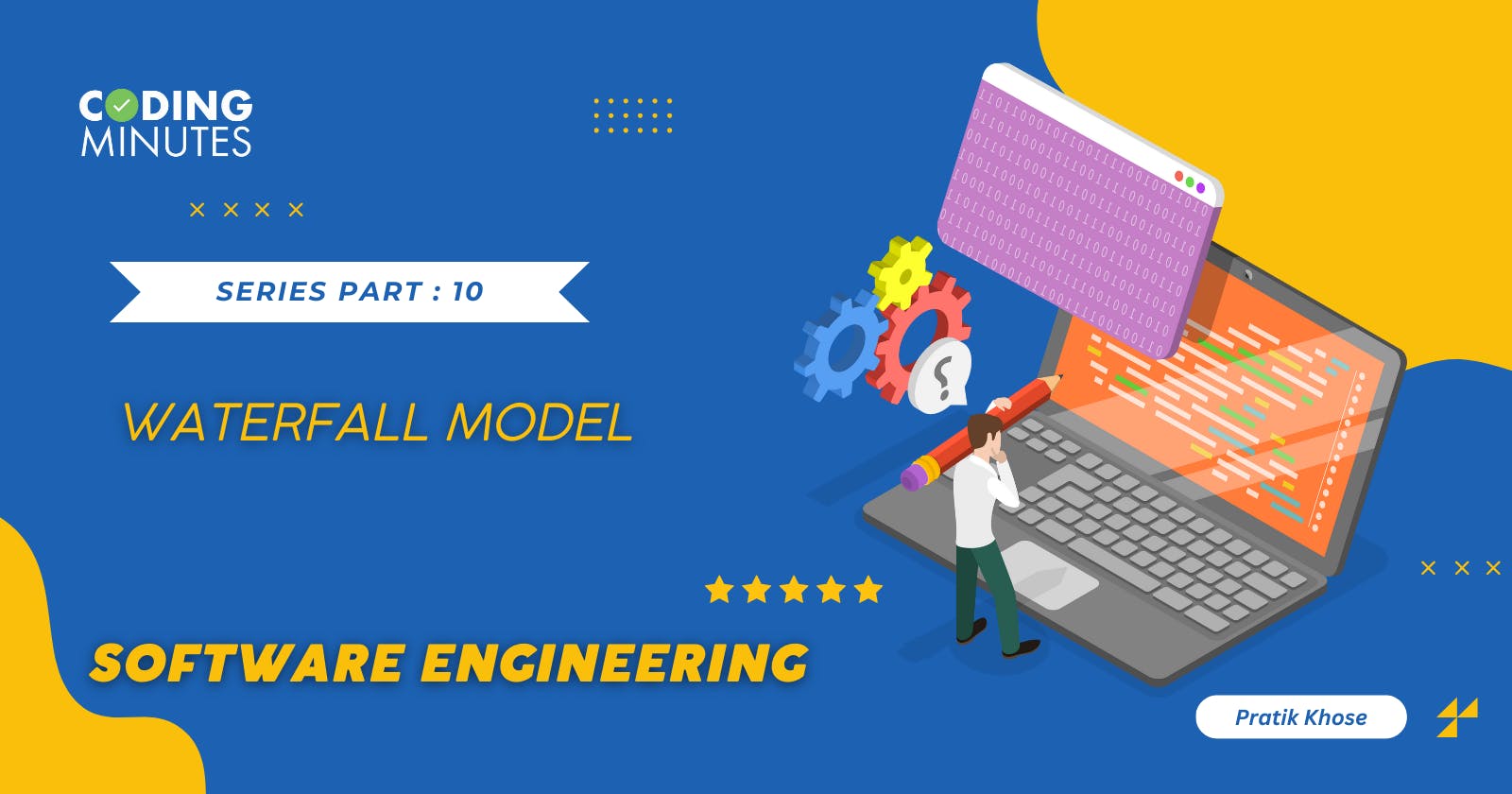The waterfall model is a simple and basic software process model that deals with either small or large but must have fixed requirements for software. This model deals with the sequential execution of tasks in various phases. Each phase is fixed and cannot be reversed unit the entire model is completed.

The waterfall model is now subdivided into two different types-
Classic waterfall model.
Iterative waterfall model.
Now let us understand each of these in every detail:-
Classic waterfall model:-
Though elegant and intuitive, the classical waterfall model is often seen as theoretical and impractical for actual software development projects. Other life cycle models are essentially derived from the classical waterfall model, making it essential for understanding various development approaches.

Phases of the Classical Waterfall Model:
Feasibility Study:-
- Aims to determine the financial and technical feasibility of developing the product.
- Initial understanding of requirements through client visits, studying input/output data, and analyzing system constraints.
- Solutions are explored, and evaluated based on resources, cost, and development time.
- The final solution's feasibility is assessed financially and technically.
Requirements Analysis and Specification:-
- Requirements specification ensures a clear understanding of customer needs to eliminate inconsistencies.
- Requirements analysis involves collecting data from users and customers through interviews and resolving contradictions and ambiguities.
- User requirements are organized into a Software Requirements Specification (SRS) document, including functional and non-functional requirements.
System and software design:-
- Transforms SRS into a structure suitable for implementation.
- Two approaches: Traditional design (structured analysis followed by structured design) and Object-oriented design (identifying objects and relationships).
Implementation and Unit Testing:-
- Translates design into source code, implementing each design component as a program module.
- Modules are individual units tested for correct functionality.
Integration and System Testing:-
Integrates and tests modules incrementally.
System testing ensures the developed system conforms to SRS requirements.
Includes α-testing (performed by the development team), β-testing (performed by a friendly set of customers), and acceptance testing (performed by the customer).
Operation and Maintenance:-
Requires more effort than development.
Involves corrective maintenance (fixing errors), perfective maintenance (improving and enhancing functionalities), and adaptive maintenance (porting software to new environments).
Limitations*:-*
- Assumes no development errors occur, which is unrealistic in practical environments.
- Engineers often commit errors detected later in the life cycle, leading to the need for revisiting and redoing work, making strict adherence to the classical waterfall model challenging.
Iterative Waterfall Model:-
Developed to address the major shortcomings of the classical waterfall model.
Introduces feedback paths for error correction within each phase, aiming to detect and rectify errors in the same phase.
Aims to provide a working model of the system at an early stage, facilitating the identification and correction of functional or design flaws.

Key Characteristics:-
Feedback Paths: Incorporates feedback paths within each phase to allow for error correction as soon as issues are detected.
Recognizes the inevitability of errors but emphasizes the importance of detecting and correcting them within the same phase.
Early Working Model: Ensures the availability of a working model of the system at an early stage of development.
Facilitates the identification of functional or design flaws early on, making it easier to take corrective measures within budget constraints.
Incremental Development: Supports incremental development, allowing the system to evolve gradually with each iteration.
Each iteration adds new functionality or refines existing features based on feedback.
Flexibility: Greater flexibility compared to the classical waterfall model.
Recognizes the dynamic nature of software development and accommodates changes more effectively.
Client Involvement: Encourages active client involvement through continuous feedback loops.
Clients can provide feedback on the working model early in the development process.
Risk Mitigation: Incorporates risk mitigation strategies through iterative cycles.
Addresses uncertainties and complexities in a more adaptable manner than the classical waterfall model.
Now let us understand the advantages and disadvantages of the Iterative waterfall model.
Advantages:
The early working model aids in the early detection of flaws, reducing the effort required for bug correction.
Corrective measures can be implemented within a limited budget.
Allows for continuous refinement throughout the development process.
Disadvantages:
Applicable primarily to large and bulky software development projects.
Breaking down small software systems into further serviceable increments/modules can be challenging.
The iterative waterfall model offers a more flexible and adaptive approach to software development, focusing on early error detection and continuous refinement. While suitable for large projects, its limitations include challenges in applying the model to smaller software systems.
Now let us understand the difference between the Classic waterfall model and the Iterative waterfall model. Key differences between the Classical Waterfall Model and the Iterative Waterfall Model:
| Feature | Classical Waterfall Model | Iterative Waterfall Model |
| Nature | Sequential, with a rigid and linear progression through phases. | Iterative, introducing feedback paths for continuous refinement. |
| Feedback Paths | Lacks explicit feedback paths for error correction within phases. | Incorporates feedback paths for detecting and correcting errors within the same phase. |
| Working Model | Develops a working model towards the end of the development life cycle. | Emphasizes an early working model for early detection of flaws and iterative refinement. |
| Flaw Identification | Flaws are typically identified later in the development cycle, leading to potential rework. | Aims for early identification of functional or design flaws, reducing the effort for bug correction. |
| Budget Considerations | Correcting errors later in the cycle may lead to increased costs and effort. | Enables corrective measures within a limited budget by identifying issues early in the process. |
| Applicability | Applicable to a variety of software development projects, including small ones. | Primarily suitable for large and bulky software development projects. Breaking down small systems into serviceable increments may be challenging. |
| Flexibility | Less flexible due to the rigid sequential nature, making adaptations more challenging. | Offers greater flexibility, allowing for continuous refinement and adaptation to changing requirements. |
| Client Involvement | Limited client involvement until the end of the development cycle. | Encourages active client involvement through continuous feedback loops during iterative phases. |
| Risk Mitigation | Less emphasis on continuous risk mitigation throughout the development process. | Incorporates risk mitigation strategies through iterative cycles, addressing uncertainties and complexities more adaptively. |
| Client Satisfaction | Client satisfaction may only be evaluated after the final product is delivered. | Provides opportunities for client feedback and satisfaction assessment at various stages of the iterative process. |
This table illustrates the fundamental differences between the Classical Waterfall Model and the Iterative Waterfall Model, emphasizing their distinct approaches to software development.

